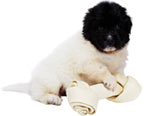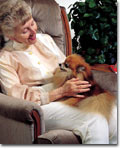Dog discipline training

| Rule 1.
Always Be Consistent |
|---|
1. The First Rule of general training is Always Be Consistent. There should be no exceptions here if you want the training to go as rapidly and as easily as possible. This relates to your actions and words. From the very start you need to decide exactly what you are trying to teach or control and how you will do it. If you are going to use a certain word or phrase as part of a command or in conjunction with a certain point you are trying to make, always say the exact same thing in the same tone of voice. This is important for all the members of a household or anyone else working with the puppy. Everyone that is involved in the training should know and use the same expression. As an example, let us think in terms of the "Come" command. It obviously will not make things go faster if you use the word "Come, " your spouse uses the word "Here, " and one of the children uses "Yo, Boy." All of this simply confuses the dog. Remember, we are trying to train him in our language; we cannot expect the puppy to be multilingual at 8 weeks of age.
Every time you give a command or are working on a training point, consistently carry it through to completion. Do not tug on the check cord for the puppy to come to you and then become distracted and forget what you are doing. If you start pulling the dog in but then stop with him halfway to you, he becomes confused. The puppy is supposed to come to you, all the way to you. If you do not ensure that happens, the puppy may think that it is okay, when given the 'Come' command, to only come in part way to you or completely ignore the command.
Try to expect the same reaction out of the puppy each time. If you use any form of praise or reward for a job well done, be consistent on how well the task in question is completed before the praise or reward is forthcoming. If the puppy is supposed to sit, do not praise him if he only bends the rear legs a little bit. People love to praise their dogs and sometimes they are so anxious to do this that the dog is hearing a string of "Good Boys, " but it has not yet completed what he was supposed to. Over time this tells the puppy that he does not have to sit all the way down but rather a slight crouch will do. The puppy will believe that close is good enough.
When you start training the dog on a particular day, think of the next few minutes as classroom time. When children are in school, there is classroom time for learning and recess for playing. The same should occur with your puppy. When you start a training session, maintain a consistent training attitude for you and your puppy. Think training and not play. Work only on training issues and do them over and over. Stay in control so it does not become playtime for the puppy. When you are not in a training session, be careful of what you say and do.
 In the early stages of training, never give a command unless you can control the puppy's actions. This is a part of consistency that many owners overlook. As an example, let us say you are currently in the process of teaching your puppy the 'Come' command. She does not respond every time yet but she is learning what the word means. You are in the backyard together playing with the puppy and children. It is recess, not classroom time. The puppy is off of her lead and suddenly takes off after a wild rabbit. Do not, we repeat, do not even think about saying "Come!" You know the puppy is not going to respond because her mind is on the rabbit and only the rabbit. If you do scream "Come, " hopefully the dog will be so distracted that she will not hear you. Because if she does recognize the command but continues after the rabbit, the puppy has just learned that when you are not in control, she can get away with ignoring what you say. During the training phase, when the puppy is doing something, and you are in a position that you are unable to control or restrain her, do not say anything. Rather move to the puppy and stop or prevent her from what it is she is doing. In the above example, you have two correct choices. You can either let her continue the chase or run and catch the puppy. Do not scream "Come."
In the early stages of training, never give a command unless you can control the puppy's actions. This is a part of consistency that many owners overlook. As an example, let us say you are currently in the process of teaching your puppy the 'Come' command. She does not respond every time yet but she is learning what the word means. You are in the backyard together playing with the puppy and children. It is recess, not classroom time. The puppy is off of her lead and suddenly takes off after a wild rabbit. Do not, we repeat, do not even think about saying "Come!" You know the puppy is not going to respond because her mind is on the rabbit and only the rabbit. If you do scream "Come, " hopefully the dog will be so distracted that she will not hear you. Because if she does recognize the command but continues after the rabbit, the puppy has just learned that when you are not in control, she can get away with ignoring what you say. During the training phase, when the puppy is doing something, and you are in a position that you are unable to control or restrain her, do not say anything. Rather move to the puppy and stop or prevent her from what it is she is doing. In the above example, you have two correct choices. You can either let her continue the chase or run and catch the puppy. Do not scream "Come."
Along the way, you may make modifications in your training method but from that point on be consistent. You may find that certain styles of training work better on your puppy. That is okay, but do not start switching back and forth. Just because one command is going slow, you should not change from method to method, hoping you find the magic formula that speeds up the process. This rarely happens and in the interim, the puppy may become hopelessly confused. We have found that any individual puppy, regardless of the method used, may have trouble with a certain command but not the others. This probably relates back to some experience in the dog's past.
| Rule 2.
Keep Training Sessions Short |
|---|
2. The Second Rule of general training is Keep Training Sessions Short. In many instances, young children can become engrossed for several hours in a game, book, or television show. Successful kindergarten teachers can make learning fun and productive often for an hour or so. However, dogs and especially puppies, do not possess long attention spans. Young puppies will not spend more than a few minutes chasing an exciting, moving stimulus like a butterfly or bird. They simply lose interest and go on to the next thing. The same is true with training, they burn out quickly and become bored. After that has happened, nothing further will be learned.
Related posts:

 Training your dog to do advanced tricks like finding something or bringing their food bowl can be done with just 10 minutes a day and some clicker training. It’s…
Training your dog to do advanced tricks like finding something or bringing their food bowl can be done with just 10 minutes a day and some clicker training. It’s… MARY ISENHOUR-LONG Owner - Trainer Photo by Stewart Event Images About The Trainer The phrase, “gone to the dogs”, is certainly an appropriate one to describe my…
MARY ISENHOUR-LONG Owner - Trainer Photo by Stewart Event Images About The Trainer The phrase, “gone to the dogs”, is certainly an appropriate one to describe my… 6 Principles of Successful Training 1. Be Consistent: Apply the same rules and the same words all the time. 2. Be Concise: Give your command just once. Repetition…
6 Principles of Successful Training 1. Be Consistent: Apply the same rules and the same words all the time. 2. Be Concise: Give your command just once. Repetition… Cesar Millan Cesar is a best-selling author, public speaker, and internationally acclaimed star of the TV shows “Dog Whisperer with Cesar Millan, ” “Leader of the…
Cesar Millan Cesar is a best-selling author, public speaker, and internationally acclaimed star of the TV shows “Dog Whisperer with Cesar Millan, ” “Leader of the… At Monument Dog Training, we believe that change is always possible . We regularly resolve aggressive behavioral issues, even with dogs who have been written off…
At Monument Dog Training, we believe that change is always possible . We regularly resolve aggressive behavioral issues, even with dogs who have been written off…